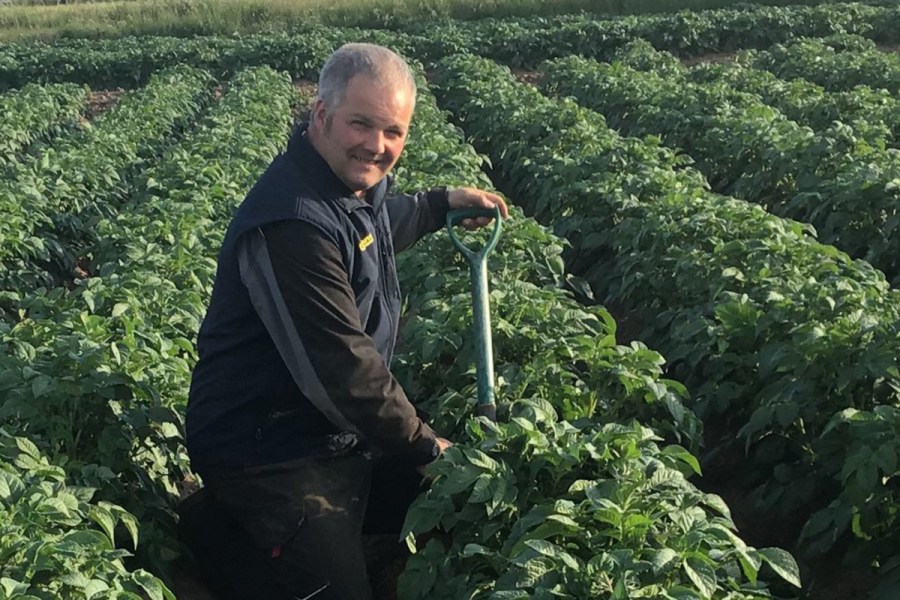By Andrew Wilson
Last month I said it would dry up soon…well it hasn’t! I can cope with a wet winter – in this part of the world we get an average of 760mm of rain per annum, so it’s almost expected. But having barely had two rain-free days since September, it’s all a bit relentless.
Furthermore, as I write this in the first week of April, we have the joys of at least another fortnight’s wet weather forecast, which about puts the tin hat on spring. We haven’t sown a seed since December.
So where do we go from here? Well, we have to sow malting barley because I sold some early on for what now looks like decent money if we can meet the spec. This has to go in asap so will follow beet lifted last and 2023 potatoes.
Feed barley will be sown on the heavier, wetter land after oats where first wheat should be, because there’s no chance of malting quality from that land this late. Spring oats will be ok sown in the next few weeks and once again I’ve sold some forward for decent money (there are always positives if one looks hard enough).
Of increasing significance to us is straw – carryover this year will be very low and at present we haven’t sown sufficient cereals to cover the next year’s requirements – it’s a safe bet that any surplus will be in demand next winter.
What’s a harder decision is whether or not to sow spring beans in April. March sown usually means October harvested which is never an attractive proposition. SFI will inevitably eat into the national bean area, so will this translate into better prices for the remaining crop? My farmer head says sow if possible, my businessman head says don’t bother.
In reality, I think we’ll do what usually works – focus on the better areas. The two wettest fields may be sown and grown on a shoestring as a cover, given the best wheat on the farm is almost always after beans. Alternative crops look like they’ll deliver more hassle than value for us, and bulk storage doesn’t encourage lots of different heaps.
SFI will feature on a small area but is mostly destined to replace our current mid-tier stewardship at the end of the year whereas our cover crops have done their job and all are now sprayed off. These will be topped as soon as ground conditions allow, to avoid planting machinery blocking with physical residue.
PotashpluS has been applied to soil requirement but muck is yet to be spread due to how soft land currently is – it’s important that we don’t create more problems than we solve, though given likely workload when the rain stops its tempting to bray on regardless.
Beet this year is on kinder land so is a bit nearer workable, though the wet ends of fields will have to wait a while yet. I don’t like part-worked fields but needs must this year. Equally, we’ll sow a few pollinator strips in strategic areas as soon as we can travel – this is of greater importance than normal due to high aphid pressure forecast by Rothamsted and BBRO.
This year’s beet is now all up and only a few loads away from delivered. Results are a long way from inspiring – dirt touching 9% and sugar barely over 15% translates to a very low adjusted paid yield with significant costs incurred. The Jackanory-like scatter graph sample results make my eyes roll but they are what they are.
2023 potatoes are now all delivered and have put in a reasonable if hardly record-breaking performance. There has been some variation in results and a few surprises that have required discussion, but solutions have been found and we go into 2024 with potatoes looking like they just might be the saving grace of the cropping year for us – if we don’t get a drought as long as the monsoon! I’m ever the optimist.
Cold, wet soils this spring raise rhizoctonia risk significantly and with a level of scurf on seed, we’ve treated the majority of stocks delivered so far with either fludioxinil or xemium on our farm-built application rig. Some varieties are tucked away in Blackburn chitting crates to increase physiological age and get them up and away a bit faster when we eventually get planting.
Trials work has provided diversification for us for many years now and this season, in addition to fungicide work, we’re looking at nitrogen use efficiency with one strip carrying a companion of volunteer beans. The results (financially and agronomically) should make interesting reading come harvest.
I’m also looking closely at trace elements in potatoes. Polysulphate has worked really well for us, particularly in reducing incidences of sulphur deficiency, but more so at improving tuber quality via the calcium being placed in the root zone. With the axe falling over mancozeb and it containing both manganese and zinc, how can we get sufficient zinc into the crop to stave off ailments such as alternaria? I’m currently researching placed nutrition while we still have mancozeb to use.
With a staff induction and a project on the go as well, we never seem to run out of wet day jobs at Brickyard Farm.
This article was taken from the latest issue of CPM. For more articles like this, subscribe here.
Sign up for Crop Production Magazine’s FREE e-newsletter here.




